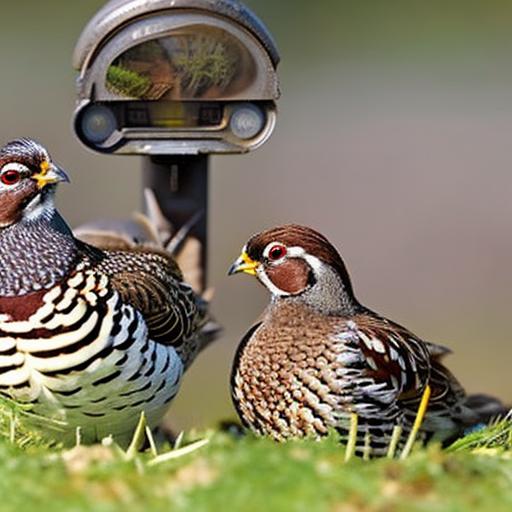Quail and chickens are both popular poultry options for backyard farming, but they have several key differences. Quail are smaller in size compared to chickens, with a more delicate build and a rounder shape. They have distinct feather patterns and colors, with some species having speckled or spotted plumage. Chickens, on the other hand, come in a wide variety of breeds, each with its own unique size, shape, and feather patterns. They are generally larger and more robust than quail, with a wider range of colors and patterns.
In terms of behavior, quail are known for being more skittish and flighty compared to chickens. They are ground-dwelling birds that prefer to run rather than fly when startled. Chickens, on the other hand, are more social and can be quite friendly and curious around humans. Additionally, quail are known for their distinctive call, which is a high-pitched chirping sound, while chickens have a wider range of vocalizations, including clucking, crowing, and squawking. Understanding these differences is crucial for successfully integrating quail and chickens in a shared living environment.
Key Takeaways
- Quail and chickens have different social behaviors and space requirements
- Quail and chickens can be compatible if introduced at a young age and given enough space
- Provide separate areas for nesting and roosting to accommodate the different needs of quail and chickens
- Quail and chickens have different dietary needs and should be fed separately
- Keep an eye out for signs of disease and ensure proper hygiene to prevent the spread of illness
- Monitor interactions to ensure that quail and chickens are not being overly aggressive towards each other
- Provide plenty of space, hiding spots, and separate feeding areas to keep quail and chickens happy and healthy
Assessing the compatibility of quail and chickens
When considering keeping quail and chickens together, it’s important to assess their compatibility to ensure a harmonious living environment. While quail and chickens are both poultry, they have different social structures and behaviors that can impact their ability to coexist peacefully. Quail are known for their skittish nature and prefer to stay in small groups, while chickens are more social and form larger flocks. This difference in social dynamics can lead to potential conflicts if not managed properly.
It’s also important to consider the size and strength differences between quail and chickens. Chickens are generally larger and more robust than quail, which can lead to issues of dominance and aggression if not carefully monitored. Additionally, quail have a tendency to startle easily and may be more susceptible to stress in the presence of larger, more assertive chickens. However, with proper planning and management, it is possible for quail and chickens to coexist peacefully and even form bonds within a shared living environment.
Creating a suitable living environment for quail and chickens
Creating a suitable living environment for both quail and chickens is essential for their health and well-being. When housing quail and chickens together, it’s important to provide adequate space to accommodate the different social dynamics and behaviors of each species. Quail prefer to stay in small groups and require less space compared to chickens, who thrive in larger flocks. Providing separate areas within the coop or aviary can help minimize potential conflicts and allow each species to have their own space.
In terms of housing design, it’s important to consider the specific needs of both quail and chickens. Quail prefer ground-level housing with plenty of hiding spots and cover to help them feel secure. Chickens, on the other hand, require roosting bars and nesting boxes at higher levels to accommodate their natural perching and nesting behaviors. Providing a mix of ground-level hiding spots and elevated roosting areas can help create a balanced living environment for both species.
Additionally, it’s important to consider the flooring and bedding materials within the coop or aviary. Quail prefer soft bedding materials such as straw or wood shavings, while chickens may require different types of bedding depending on their breed and individual needs. Regular cleaning and maintenance of the living environment is crucial for preventing the buildup of waste and minimizing the risk of disease transmission between quail and chickens.
Managing the feeding and nutrition of quail and chickens
Managing the feeding and nutrition of quail and chickens requires careful consideration of their specific dietary needs. Quail are omnivorous birds that require a diet high in protein to support their growth and egg production. They can be fed a commercial game bird feed or a mix of seeds, grains, insects, and greens to ensure they receive the necessary nutrients. Additionally, providing access to grit or small stones is essential for quail to aid in digestion.
Chickens have similar dietary requirements but may require different formulations of feed depending on their age, breed, and purpose (e.g., egg-laying hens versus meat-producing broilers). They also benefit from a diet high in protein, which can be provided through commercial poultry feed or a mix of grains, seeds, insects, and kitchen scraps. Additionally, providing access to calcium supplements such as oyster shells is crucial for supporting eggshell formation in laying hens.
When housing quail and chickens together, it’s important to provide separate feeding areas to prevent competition and ensure that each species receives adequate nutrition. Additionally, monitoring their feeding behaviors can help identify any potential issues or imbalances in their diet. Providing fresh water at all times is essential for both quail and chickens to support their overall health and well-being.
Addressing potential health concerns and diseases
Addressing potential health concerns and diseases is crucial when keeping quail and chickens together. Both species are susceptible to a range of common poultry diseases such as coccidiosis, Marek’s disease, and respiratory infections. It’s important to monitor their overall health and behavior regularly to identify any signs of illness or distress.
When housing quail and chickens together, it’s important to implement biosecurity measures to minimize the risk of disease transmission between the two species. This includes regular cleaning and disinfection of the living environment, as well as quarantine procedures for introducing new birds into the flock. Additionally, providing access to dust baths for both quail and chickens can help control external parasites such as mites and lice.
Seeking veterinary care from a poultry specialist is essential for addressing any health concerns or diseases that may arise in a mixed-species flock. It’s important to work with a veterinarian who has experience with both quail and chickens to ensure that they receive appropriate care and treatment. Implementing proactive measures such as vaccination programs can also help prevent the spread of common poultry diseases within a mixed-species flock.
Monitoring social dynamics and behavior between quail and chickens

Monitoring social dynamics and behavior between quail and chickens is essential for ensuring their well-being within a shared living environment. When introducing quail and chickens into the same space, it’s important to observe their interactions closely to identify any signs of aggression or stress. Quail are known for being more skittish compared to chickens, so it’s important to provide plenty of hiding spots and cover to help them feel secure.
Additionally, monitoring their social dynamics can help identify any potential issues with dominance or bullying within the flock. Providing multiple feeding areas and resources can help minimize competition between quail and chickens and ensure that each species has access to food and water without conflict. It’s also important to observe their roosting behaviors to ensure that both quail and chickens have adequate space to rest comfortably.
Understanding the natural behaviors of both quail and chickens can help create a harmonious living environment where they can coexist peacefully. Providing enrichment activities such as dust baths, foraging opportunities, and perching areas can help keep both species mentally stimulated and physically active. Regular observation of their social dynamics can help identify any potential issues early on and prevent conflicts from escalating within the flock.
Tips for successfully keeping quail and chickens together
Successfully keeping quail and chickens together requires careful planning, management, and observation to ensure their well-being within a shared living environment. Here are some tips for integrating quail and chickens in a harmonious flock:
1. Provide adequate space: Ensure that the coop or aviary provides enough space to accommodate the different social dynamics and behaviors of quail and chickens.
2. Separate feeding areas: Provide separate feeding areas to prevent competition between quail and chickens and ensure that each species receives adequate nutrition.
3. Monitor social dynamics: Regularly observe their interactions to identify any signs of aggression or stress within the flock.
4. Implement biosecurity measures: Practice regular cleaning, disinfection, and quarantine procedures to minimize the risk of disease transmission between quail and chickens.
5. Seek veterinary care: Work with a poultry specialist veterinarian who has experience with both quail and chickens to address any health concerns or diseases that may arise.
6. Provide enrichment activities: Offer enrichment activities such as dust baths, foraging opportunities, and perching areas to keep both species mentally stimulated and physically active.
By following these tips and understanding the differences between quail and chickens, it is possible to create a harmonious living environment where both species can thrive together in a mixed-species flock. With careful planning and management, quail and chickens can coexist peacefully while providing joy, companionship, and valuable resources for backyard farmers.
If you’re considering keeping quail and chickens together, it’s important to ensure that they have adequate space and suitable living conditions. According to a helpful article on PoultryWizard.com, “Where to Put Chicken Coop,” the location of the coop plays a crucial role in maintaining the health and well-being of your poultry. It’s also essential to consider converting a shed into a chicken coop, as discussed in another informative piece on the same website. Additionally, if you’re looking for practical tips on building a chicken coop in Muskegon, be sure to check out the article “Chicken Coop Muskegon” for valuable insights. These resources can provide valuable guidance for creating a harmonious environment for both quail and chickens. Source
FAQs
Can you keep quail and chickens together?
Yes, it is possible to keep quail and chickens together in the same coop or enclosure.
What are the benefits of keeping quail and chickens together?
Keeping quail and chickens together can provide companionship for the birds and can also help in maximizing space and resources.
Are there any potential issues with keeping quail and chickens together?
There can be potential issues with keeping quail and chickens together, such as differences in dietary needs and the potential for aggression between the two species.
What should be considered when keeping quail and chickens together?
When keeping quail and chickens together, it is important to provide separate feeding and watering stations to ensure that each species gets the appropriate nutrition. Additionally, providing enough space and hiding spots for the quail to escape potential aggression from the chickens is important.
Can quail and chickens share the same feed?
While quail and chickens can share some of the same feed, it is important to provide specialized feed for each species to ensure that they are getting the appropriate nutrition for their specific needs.
What are some tips for successfully keeping quail and chickens together?
Some tips for successfully keeping quail and chickens together include providing ample space, separate feeding and watering stations, and monitoring the behavior of the birds to ensure that they are cohabitating peacefully.
Meet Walter, the feathered-friend fanatic of Florida! Nestled in the sunshine state, Walter struts through life with his feathered companions, clucking his way to happiness. With a coop that’s fancier than a five-star hotel, he’s the Don Juan of the chicken world. When he’s not teaching his hens to do the cha-cha, you’ll find him in a heated debate with his prized rooster, Sir Clucks-a-Lot. Walter’s poultry passion is no yolk; he’s the sunny-side-up guy you never knew you needed in your flock of friends!







